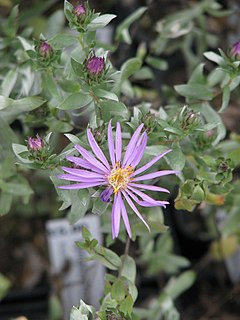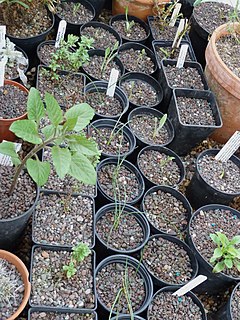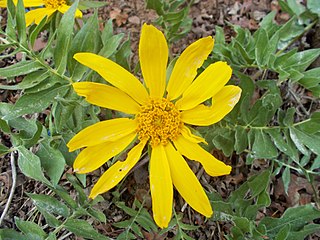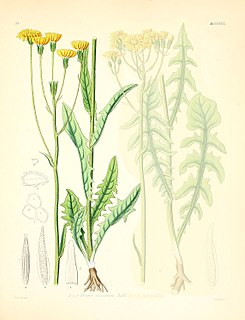
Coreopsis rosea is a North American species of Coreopsis in the family Asteraceae. It has a discontinuous distribution in the eastern United States and Canada, found in Nova Scotia, Massachusetts, Rhode Island, New York, New Jersey, Pennsylvania, Delaware, Maryland, Georgia, and South Carolina.

Balsamorhiza is a genus of plants in the family Asteraceae known commonly as balsamroots. These are perennials with fleshy taproots and caudices bearing erect stems and large, basal leaves. Atop the tall stems are showy yellow sunflower-like blooms. Balsamroots are native to western North America.

Erigeron strigosus is a species of flowering plant in the family Asteraceae known by the common names prairie fleabane, common eastern fleabane, and daisy fleabane.

Symphyotrichum sericeum is a species of flowering plant in the family Asteraceae native to central North America. Commonly known as western silver aster, western silvery aster, and silky aster, it is a perennial, herbaceous plant that may reach 70 centimeters tall. Its flowers have purple ray florets and pink then purple disk florets, and its leaves are firm and silvery-green.

Balsamorhiza deltoidea is a species of flowering plant in the sunflower tribe of the plant family Asteraceae known by the common name deltoid balsamroot. It is native to western North America from British Columbia to California, where it grows in many types of generally mountainous habitat.
Balsamorhiza macrolepis is a species of flowering plant in the tribe Heliantheae of the family Asteraceae, known by the common name California balsamroot. It is found only in California, where it grows in dry, open habitat, mostly in mountainous areas, mostly in the western foothills of the Sierra Nevada and in the eastern Coast Ranges near San Francisco Bay. It is now becoming rare in the Coast Ranges.

Balsamorhiza sagittata is a North American species of flowering plant in the tribe Heliantheae of the family Asteraceae known by the common name Arrowleaf Balsamroot. It is widespread across western Canada and much of the western United States. A specimen was collected by explorer and botanist Meriwether Lewis near Lewis and Clark Pass in 1806.

Balsamorhiza sericea is a species of flowering plant in the tribe Heliantheae of the family Asteraceae known by the common name silky balsamroot. It is native to the Klamath Mountains of northwestern California and southwestern Oregon, with additional populations in the Blue and Steens Mountains in eastern Oregon. It grows in rocky areas, sometimes on serpentine soils.

Bidens aristosa is a North American species of plants in the sunflower family. Common names include bearded beggarticks, western tickseed, long-bracted beggarticks, tickseed beggarticks, swamp marigold, and Yankee lice. It is native to eastern and central United States and south-central Canada, from Maine south to Florida and west as far as Ontario, Texas, and Nebraska. It grows in wet meadows and abandoned fields.

Ratibida pinnata is a species of flowering plant in the family Asteraceae known by the common names pinnate prairie coneflower, gray-head coneflower, yellow coneflower, and prairie coneflower. It is native to the central and eastern United States and Ontario in Canada.

Symphyotrichum prenanthoides is a species of flowering plant in the family Asteraceae known by the common name crookedstem aster. It is native to northcentral and northeastern North America.

Balsamorhiza hispidula is a North American species of plants in the sunflower tribe within the aster family. It is native to western United States, primarily the Great Basin and other dry, relatively flat terrain. It has been found in Idaho, Montana, Wyoming, Oregon, Nevada, Colorado, Utah, and Arizona.

Balsamorhiza incana is a North American species of plants in the tribe Heliantheae of the family Asteraceae. It is native to the northwestern United States, in Idaho, Montana, Wyoming, Washington, and Oregon.

Balsamorhiza macrophylla is a North American species of plants in the tribe Heliantheae of the family Asteraceae. The species is native to the northwestern United States, in Idaho, Montana, Wyoming, Utah, and Oregon. It grows in sagebrush scrublands and conifer forests. It sometimes hybridizes with Balsamorhiza sagittata.
Balsamorhiza serrata is a North American species of plants in the tribe Heliantheae of the family Asteraceae.
Balsamorhiza lanata, with the common name lanate balsamroot, is a species of plant in the tribe Heliantheae of the family Asteraceae native to California.

Crepis nicaeensis is a European species of flowering plant in the family Asteraceae with the common names French hawk's-beard and Turkish hawksbeard. It is widespread across much of Europe, as well as being sparingly naturalized in scattered locations in the United States and Canada.

Crepis rubra is a European species of flowering plant in the family Asteraceae with the common name red hawksbeard or pink hawk's-beard. It is native to the eastern Mediterranean region and is widely cultivated as an ornamental. It became naturalized in a small region of the United States.

Calyptocarpus vialis is a species of flowering plant in the family Asteraceae. Common names for C. vialis include straggler daisy, horseherb, lawnflower, and creeping Cinderella-weed. It is native to the southern United States, Mexico, Belize, Venezuela, and the Caribbean. It has also been introduced to Argentina, Hawaii, India, Java, Australia, and Taiwan. It is one of only three species in the genus Calyptocarpus.

Symphyotrichum eulae is a species of flowering plant in the family Asteraceae endemic to Texas. Commonly known as Eula's aster, it is a perennial, herbaceous plant that may reach 5 to 150 centimeters tall. Its flowers have white to lavender-pink ray florets and yellow then red to brown disk florets. It was named for Eula Whitehouse, American botanist, botanical illustrator, and plant collector.
















